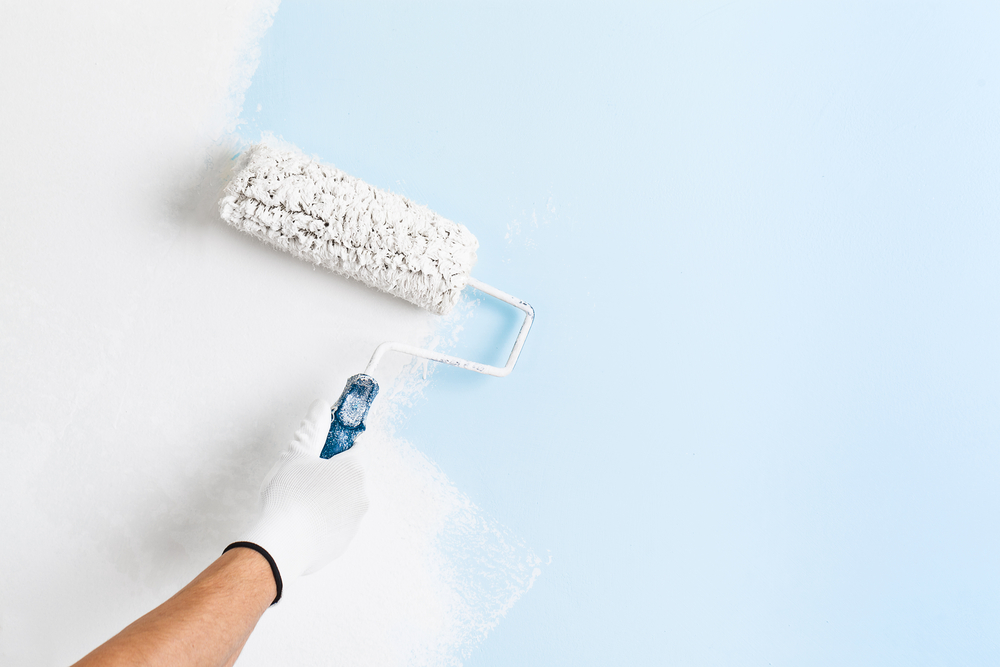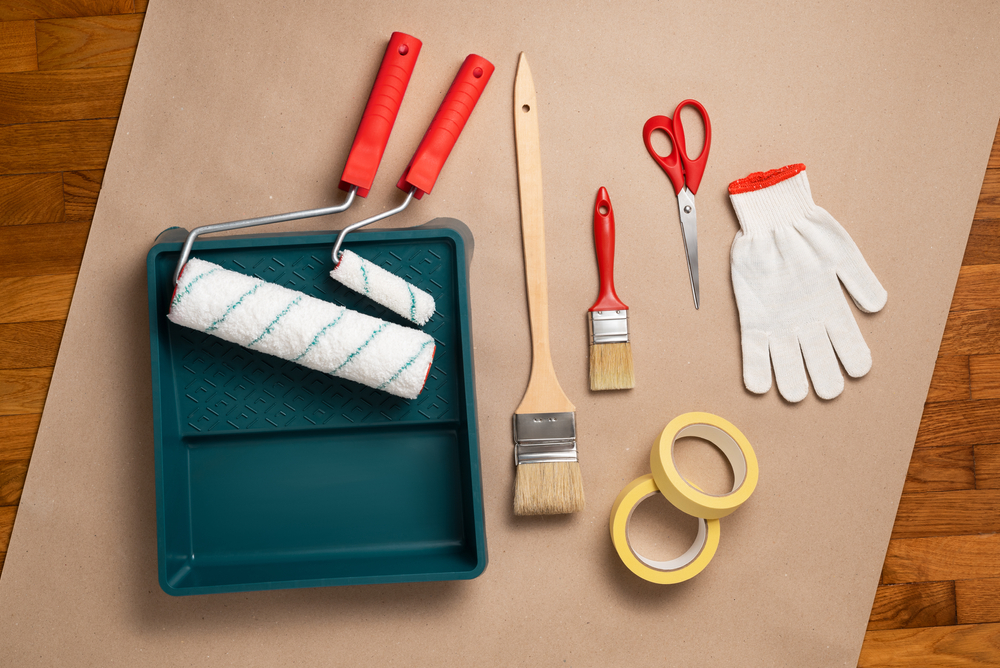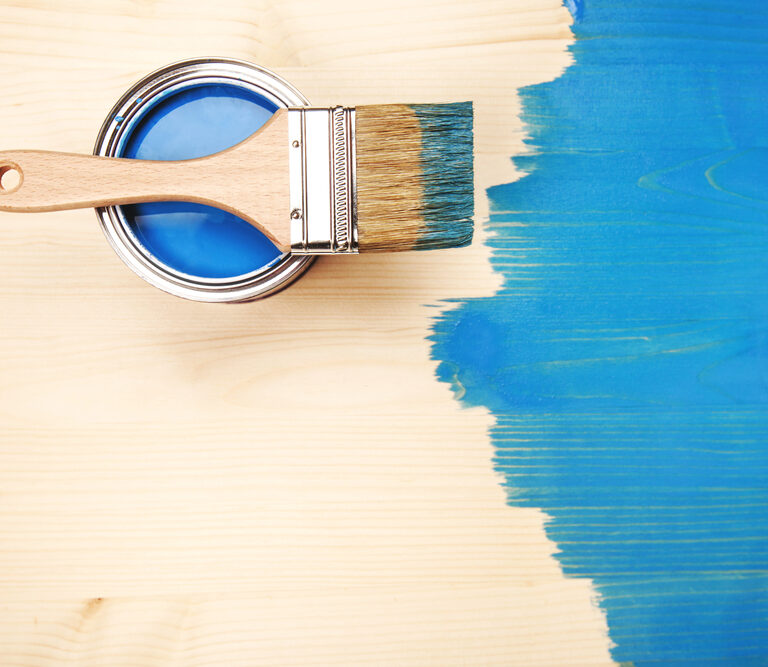As much as a new, fresh coat of latex paint can brighten up your most recent DIY project, even the most experienced hands can expect to deal with paint splatters, and at times, a horrifying paint spill.
The best way to remove the paint properly depends on the affected surface. When this happens, it’s up to you, aspiring handy-person, to know exactly how to clean up the mess.
Luckily, we’ve got all the best tips and tricks on how to remove latex paint from different surfaces, such as cloth, glass, brushes, concrete, and wood.
What Is Latex Paint?
Latex paint is an umbrella term that covers the types of paint that use water as their solvent.
Originally referring to rubber-based solids (the actual paint that is left over after the solvent has dried up), modern latex paints now vary between plastic resin such as polyvinyl or acrylic instead of rubber.
This kind of paint is widely loved for its versatility, application, and, most of all, its ability to be easily washed off with water—well, perhaps with a little effort, too. Here’s how it’s done.
How to Remove Latex Paint
This section will discuss step-by-step instructions on how to remove latex paint from five different surfaces: clothing, glass, brushes, concrete, and wood.
Clothing and Carpets
So, you weren’t careful, and now you’ve got splashes of color on your clothes that shouldn’t be there. Thankfully, since latex is water-based, it’s much easier to remove from fabric than oil-based paints are.
Carpets, obviously, will require a bit more effort, but the general process is still similar to other fabric-based items.
What You Need
- Bowl of water, preferably warm
- Two spoons of mild liquid soap
- Razorblade
- Dry rags
- Vacuum (optional)
Steps to Remove Latex Paint From Clothing and Carpets
- Mix two spoons of liquid soap and water until you have a bubbly mixture.
- Remove as much paint as you can from the cloth or carpet before applying the mixture. You can do this by gently scraping it off with a razor or by dabbing it with a dry rag if the paint is still wet.
- Apply a generous amount of the mixture to the area where there is paint, completely soaking it.
- Use clean rags to blot the paint, working from the outside in. Make sure to blot the paint in straight, downward motions while pressing down firmly so as not to spread it around even more.
- The previous step should be enough to get rid of smaller-sized paint blots. If some paint remains, you can use a vacuum to suck up the loosened paint. Make sure to secure small pieces of fabric so that it doesn’t block the vacuum nozzle and create more problems.
Glass Surfaces
Glass surfaces aren’t absorbent, which means paint doesn’t stick to them much. That said, you still have to be careful when stripping paint from glass surfaces. Although they’re the easiest type of surface to clean on this list, they’re also the most delicate and could potentially break if you’re not careful.
What You Need
- Water
- Glass cleaner
- Blade scraper
- Dry rags
- Vinegar (optional)
- Nail polish remover (optional)
Steps to Remove Latex Paint From Glass Surfaces
- Create a protective layer of liquid on the glass surface by coating it with a light splash of water or glass cleaner. This will soften the paint as well as protect the surface of the glass from minor abrasions that might happen during the cleaning process.
- Lay the bladed edge of the scraper on the edge of the paint splatter. Slowly but firmly push it across the paint stain.
- Periodically apply water to the paint to soften it further. A softer paint blot is an easier-to-clean blot.
- If it stays hard and is difficult to scrape even after using water, you can try using a rag soaked in hot water. If this still doesn’t work, you can also add vinegar or nail polish remover to the hot rag.
- Continue firmly scraping across the blot until you peel all of the paint off.
- Wipe the glass with a clean rag when you finish.
Paint Brushes and Reusable Rollers
Not only can it be a pesky chore to buy painting materials over and over again for a single project, but it can also be very expensive, especially if it’s a major undertaking.
To avoid unnecessary damages to your wallet as well as to the environment, you should learn how to squeeze as much utility as you can out of your best paint brushes and rollers. This includes knowing how to remove latex paint from them to make them reusable.

What You Need
- Water, hot and lukewarm
- Fabric softener
- Container
Steps to Remove Latex Paint From Paint Brushes and Rollers
- Run the brush or roller under a stream of water and gently squeeze out the excess paint from them. Once the water starts running clear, move on to the second step.
- Mix hot water and three tablespoons of fabric softener in a container. Fabric softener enhances the capabilities of water to make it more absorbent. It will also soften the paint on your brushes and rollers, allowing you to remove it more easily.
- Dip your equipment into the mixture and soak for a minute or so. The soaking time depends on how large your paint brushes are and how much paint they’ve accumulated.
- After soaking, swirl the paint brush or roller around to dislodge the paint from the bristles. You can also manually scrub the paint off using your hands.
- When there are no more traces of paint on the brush, remove from the mixture and soak in fresh, warm water for several hours.
- After this, rinse your rollers and brushes under flowing water. Run a brush comb through dried paint brushes or rollers to dislodge flakes that were tangled in the bristles or fabric.
- If there are still pesky paint residues remaining, consider soaking the brushes again in hot water and fabric softener until the paint completely washes off.
Concrete Surfaces
Dried paint on concrete surfaces can be very difficult to remove due to the highly absorbent nature of concrete. Because of this, many people tend to just accept its existence without ever bothering to clean it up.
But if the dried paint is of the water-based variety, such as latex, then you’re going to have a much easier time. You should try using water first to scrub away the paint. If it doesn’t work, then you’ll need a commercial paint stripper to do the job for you.
What You Need
- Paint stripper
- Paintbrush or rollers
- Protective gear
- Putty knife or paint scraper
- Steel wool scrubs
- Broom
- Dustpan
Steps to Remove Latex Paint From Concrete Surfaces
- Clean the concrete surface that you’re stripping paint from. Use a broom to sweep away dust and debris, then scrub the surface with soap and water. You can use a pressure washer or a garden hose to wash away the soap suds.
- Allow the cleaned surface to dry for several hours.
- Apply the paint stripper liberally to the cleaned surface. Paint strippers contain toxic chemicals, so you shouldn’t let them touch any part of your skin. We recommend using chemical-resistant gloves, like these from the Wells Lamont brand.
- Let the stripper sit on the surface. This can last from several minutes to a few hours, depending on how much paint you need to remove. Avoid hot or windy areas as the paint stripper might dry prematurely.
- Scour the softened paint off the surface. Use a paint scraper and a durable steel wool scrub to completely remove the paint from the surface.
- Repeat until you completely remove the paint from the surface. If this is proving difficult, you could also use industrial-grade paint stripper disks (that are attached to drill bits) for an easier time, such as the Ultra Stiff Drill Cleaning Brush.
- Wash the area with water and check if there are still paint spots. Repeat steps 3-6 until all stains have been eradicated.
Wood and Furniture
Removing latex paint from wood is actually easier than you might have thought. In fact, if you only need to remove paint drips, you can create a homemade mixture of lemon juice and rubbing alcohol together to rub away the paint.
For more stubborn paint stains, though, you will need a commercial paint stripper.
What You Need
- Paint stripper
- Paintbrush
- Safety gear
- Dry rags
- Putty knife/paint scraper
- Plastic sheeting
- Steel wool scrubs
Steps to Remove Latex Paint From Wood and Furniture
- Prepare your work area. Remember, when using a solvent-based paint stripper, the primary concern is ventilation. Toxic fumes, as explained in more detail below, are a serious health risk.
If you’re working with something that could be carried outside, then do so. If you’re working with non-removables like walls or floors, make sure that the room you’re in has a couple of open windows or steadily flowing air, like from a fan.
- Dirt and grime will lessen the efficacy of the paint stripper, so you have to thoroughly clean the surface first. For particularly dirty areas, use soap and water.
- Apply a generous, even layer of paint stripper and let it sit for 15-20 minutes or until bubbles appear. This gives the stripper enough time to soak into the paint, but not so much that it goes through the wood surface.
- Use your putty knife to scrape the softened paint off the wooden surface. Take care not to damage the wood as you scrape.
- Repeat steps 2-5 as you see fit. Depending on how much paint you need to remove, you may need to do this a couple of times. Clean the surface each time so that you can properly assess which area needs more stripping.
- Use your steel wool scrub to remove the last of the paint from the wooden surface. Finally, use water to wash it off.
Safety Considerations When Removing Latex Paint
Your safety should be your highest priority when dealing with chemical cocktails that are toxic or potentially flammable. In this section, we’ll tell you all the safety considerations you need to think about before you get started on your paint removal project.

Don’t Forget Protective Wear
Like we’ve emphasized throughout this article, you should always take measures to minimize health and safety risks.
Wear old clothes, chemical-resistant gloves, and face masks that you can dispose of after the activity.
Careful With Flammable Chemicals
The chemicals used in paint strippers are highly flammable, which means they can cause accidents if you’re careless.
To minimize this hazard, don’t use alcohol or solvents anywhere near open flames. Also, stay away from electronics as they can sometimes emit sparks. Remember, it only takes a single spark to start a whole fire.
More importantly, never use such chemicals in a closed, poorly-ventilated room. Vapors and fumes can accumulate and not only poison you, but also drastically increase the risk of fire.
Avoid Toxic Fumes
In addition to being highly flammable, these chemicals also often give off toxic fumes.
Be especially wary of solvents like toluene and xylene, which dissolves toxic molecules very easily into the air. Never use ammonia and paints with high VOC (Volatile Organic Compounds) content in closed rooms. Paint outside whenever possible. If you can’t, make sure to ventilate the area well.
Always Clean With Water
Make it a habit to wash down surfaces with a good amount of water after every paint removal process.
This is even more important if you’re using commercial paint strippers, as they are likely to contain methylene chloride – a chemical that can cause chemical burns, among other things. Washing the area with water will not only tidy up the project but will also minimize the chances of toxic substances remaining on the surface.
Beware of Lead-Containing Paints
Latex paints don’t usually contain lead, but if you’re dealing with old latex paint, it’s always better to be more cautious.
Any paint made before 1978 can generate extremely dangerous material that contains lead. Lead-containing flakes, chips, or even dust, can present serious health hazards. As such, you should always wear complete protective gear when removing old paint. In fact, eye goggles, HEPA respirators, and activated carbon filters, are recommended when dealing with paint that contains lead.
In addition to this, make sure to observe proper working practices as well. When dealing with old paint, remove everything that you can from the vicinity – you wouldn’t want lead dust to settle on them that could be inhaled by others at a later date. Always keep pregnant women, children, and animals away from your working area when dealing with lead paint.
Removing Latex Paint
Latex paint is indeed a wonder of modern technology. But although it’s easier to clean than other oil-based paints, it’s still not always a walk in the park. Luckily, there are a variety of things you can do to eliminate paint stains from a variety of surfaces.
To summarize, use water and soap for clothing and carpet stains; glass cleaner, a hot rag, and vinegar or acetone for glass surfaces; hot water and fabric conditioner for rollers and paint brushes; and a fully equipped application of commercial paint strippers for both wood and concrete surfaces.
If you followed the guide above, then you (as an aspiring handy-person) should have no problem dealing with whatever paint spillage crisis comes your way.
